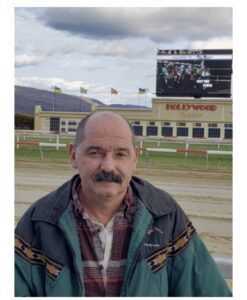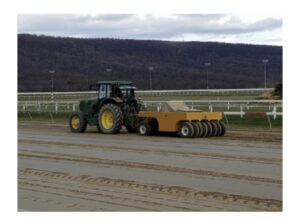
The image of horses ‘dashing through the snow’ is a pretty picture, but for horses, drivers, and jockeys on a racetrack, snow can cause dangerous conditions. The Track Superintendent’s job is extremely important to monitor, maintain, and watch over the racing surface in all weather, but when winter rears its ugly head, track maintenance is taken to the next level. For two of the tracks in Pennsylvania, the men in charge are working around the clock to keep the racing safe for all involved.
Bruce Smith is the Track Superintendent at Hollywood Casino at the Meadows Racetrack, and is already anticipating the wintry conditions. He’s more than ready to meet the challenge, and is always looking ahead to see what the weather will bring.
“I look at the forecast three or four days in advance, but it’s never really right until the day before, when they can actually pinpoint what it’s going to do,” he said. “There’s actually two different kind of weathers to worry about-there’s snow, and then there’s the extreme cold. I’d rather deal with the extreme cold, because then you don’t have to worry about where you are going to put the snow. With extreme cold, the key there is to make sure that we maintain a decent cushion on the racetrack before it freezes. We call it freeze-drying. In other words, there’s moisture in the track, and it’s frozen, but it’s frozen and loose, and still maintains its cushion, so that’s easier to work with.” He added that waiting for the temperature to go down is imperative so that they can maintain it and get the proper cushion.
When there’s snow, it’s a totally different story. “If it’s going to snow, you don’t want any cushion in it! It sounds complicated, I know,” he laughed. “So if they were calling for 3-4” of snow, we’d want the track to be a loose cushion, but a smooth cushion. We call it ‘smooth’ or ‘screened down’, but not hard. In other words, when you take the snow off, you’re not going to take all your cushion with you. You never take the snow off while it’s snowing.”
Bruce has a hard-working crew of four guys; two morning and two afternoon guys. “My morning guy will call me, sometimes two or three o’clock in the morning, and we’ll look at the weather right at that time, and if there no snow in the forecast, I’ll tell him to go ahead and harrow it in, because we know it’s going to be an inch or less. But if it’s more, then you leave it cover.”

As one of the few tracks in Pennsylvania that has a barn area, Bruce has to make sure that the track is ready for morning training and jogging, as well. “There’s close to 800 horses stabled here, and they’re all waiting to get out there at 6am!” he laughed. “That makes our job tougher, because we have to be ready for post time of 1pm. So there’s where I have to make the decision, are we going to let them on the track, and possibly create some problems with the surface? Or do we close the track? It’s a fine line to walk, because everyone wants to get out there and get their horses out of the barn, and I understand that. But the word from my bosses is, if we have to keep the track closed in the morning to get ready for racing, then so be it.”
Keeping the surface in top racing form in the winter with an afternoon post time sometimes is a challenge. “If you have a track that is freeze-dried in the morning, you have cushion and it’s not wet. But as the sun comes out, it wants to turn, and depending on how much moisture is in it, it could get sloppy. If we raced at night, the temperature would be going the other way, and you would be able to freeze-dry it again, and it wouldn’t be a sloppy track.”
Bruce took over from the former Track Superintendent Corwyn Greene in 2013. “He was there for 35 years, and I learned everything from him. He’s still there for me, if I need anything. He knows that track like the back of his hand.” With Bruce now in charge of the surface, the track is in very good hands for the year-round racing at the Meadows.
At Hollywood Casino at Penn National Race Course, thoroughbred racing is also year-round, and Track Superintendent Jake Leitzel starts preparing in early October for the winter months ahead. “We start by adding sand to help break down the clay content that’s in it, and that usually takes a good week to get it broken down. Then we start adding salt by the middle of November, or when the temperature drops below 20-25 degrees,” he explained.
When a winter storm is forecast to hit around post time, Jake and his crew are at the track around the clock. “I have three guys and me here all night long, and we’re constantly on the racetrack, preparing it for the storm. We let all the snow fall, and build up on the racetrack, and then we take it all off at one time. So if they’re calling for more than 2”, and we have a dry track, we can work up to 2” into the racetrack. Now if we have a track that has moisture, we have to take 2” off. We can’t work it in, especially if they are calling for below freezing temperatures for a few days.”

With freezing rain, Jake found out years ago that, even though there’s not a whole lot you can do with it, he found a solution that works. “The best thing to do is to keep working the track with the floats and the teeth, and keep mixing it in. Once you get ice buildup on the racetrack, then you go to break it down, and you end up with ice chunks in the racetrack, and then you get ice balls, and if you have below freezing temperatures, they just don’t melt. Freezing rain is our biggest problem.”
Jake has been with the track for over 30 years, and in his current position for 16 years. He’s been through many tough winter seasons. “We’ve had to cancel racing quite a few times. Sometimes it was to prepare ourselves for the following race day, because we don’t like to work too much snow into the racetrack, and have it melt down, and then freezing temperatures come, and you end up with a frozen racetrack. In the winter, what we try to do is keep as much moisture out of the racetrack as possible.”
Horses are stabled at Penn National, and need to train in the mornings, so Jake and his crew need to have the track ready, but if the weather is questionable, for the safety of everyone, the track opens later. “If we have problems with it clumping up overnight, we’ll open training up late. The longest I can extend it is to noon, but I won’t go past noon for training.”
Watching the weather is something Jake does all day and night. “I dream the weather in the winter time,” he laughed. “I’m constantly watching the weather, and my guys are very good at watching it, too. I live an hour away from the track, so when we’re expecting real bad weather, the company will put me up in a motel right across the street, so I can be here at all times. In the winter time, I don’t get much sleep!”
Both gentlemen are hoping for an early spring, but for now, they are prepared and ready for winter, and will be working hard to keep the track surfaces safe, and the racing exciting for those cold winter days and nights.
Cover photo by Chris Gooden











